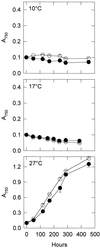Iron superoxide dismutase protects against chilling damage in the cyanobacterium synechococcus species PCC7942
- PMID: 10318704
- PMCID: PMC59259
- DOI: 10.1104/pp.120.1.275
Iron superoxide dismutase protects against chilling damage in the cyanobacterium synechococcus species PCC7942
Abstract
A strain of Synechococcus sp. PCC7942 lacking functional Fe superoxide dismutase (SOD), designated sodB-, was characterized by its growth rate, photosynthetic pigments, inhibition of photosynthetic electron transport activity, and total SOD activity at 0 degrees C, 10 degrees C, 17 degrees C, and 27 degrees C in moderate light. At 27 degrees C, the sodB- and wild-type strains had similar growth rates, chlorophyll and carotenoid contents, and cyclic photosynthetic electron transport activity. The sodB- strain was more sensitive to chilling stress at 17 degrees C than the wild type, indicating a role for FeSOD in protection against photooxidative damage during moderate chilling in light. However, both the wild-type and sodB- strains exhibited similar chilling damage at 0 degrees C and 10 degrees C, indicating that the FeSOD does not provide protection against severe chilling stress in light. Total SOD activity was lower in the sodB- strain than in the wild type at 17 degrees C and 27 degrees C. Total SOD activity decreased with decreasing temperature in both strains but more so in the wild type. Total SOD activity was equal in the two strains when assayed at 0 degrees C.
Figures








References
-
- Asada K, Endo T, Mano J, Miyake C. Molecular mechanism for relaxation of and protection from light stress. In: Satoh K, Murata N, editors. Stress Responses of Photosynthetic Organisms. Amsterdam: Elsevier; 1998. pp. 37–52.
-
- Asada K, Takahashi M-A. Production and scavenging of active oxygen in photosynthesis. In: Kyle DJ, Osmond CB, Arntzen CJ, editors. Photoinhibition. Amsterdam: Elsevier; 1987. pp. 227–287.
-
- Asada K, Takahashi M-A, Nagate M. Assay and inhibitors of spinach superoxide dismutase. Agric Biol Chem. 1974;38:471–473.
-
- Bannister JV, Bannister WH, Rotilio G. Aspects of the structure, function and applications of superoxide dismutase. CRC Crit Rev Biochem. 1987;22:111–180. - PubMed
-
- Beyer WF, Jr, Fridovich I. Assaying for superoxide dismutase activity: some large consequences of minor changes in conditions. Anal Biochem. 1987;161:559–566. - PubMed
LinkOut - more resources
Full Text Sources
Other Literature Sources

